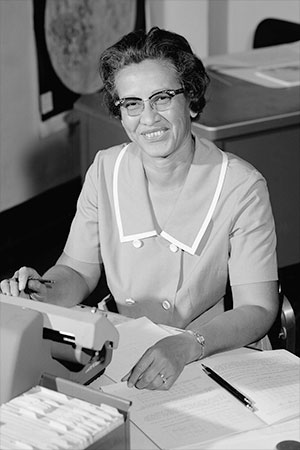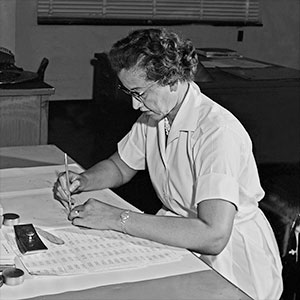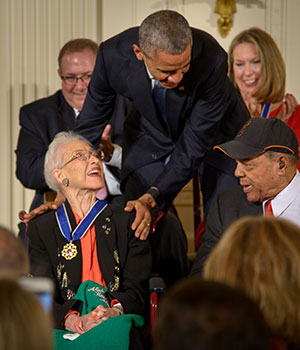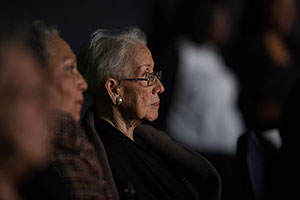 advertisements advertisements
|

|
Katherine Johnson, NASA mathematician who calculated astronauts' trajectories, dies at 101
February 24, 2020 — Katherine Johnson, a once-"hidden figure" who calculated and verified the trajectories for NASA's early astronauts' spaceflights, has died at the age of 101.
Johnson's death on Monday (Feb. 24) was confirmed by NASA.
"NASA is deeply saddened by the loss of a leader from our pioneering days, and we send our deepest condolences to the family of Katherine Johnson," NASA Administrator Jim Bridenstine said in a statement. "Ms. Johnson helped our nation enlarge frontiers of space even as she made huge strides that also opened doors for women and people of color in the universal human quest to explore space."
"We will never forget her courage and leadership and the milestones we could not have reached without her," said Bridenstine.
As dramatized in the 2016 feature film "Hidden Figures," Johnson was among the group of African American women at NASA's Langley Research Center in Virginia who in the late 1950s and early 1960s worked as "human computers," performing the mathematics to support the work of the Space Task Group prior to the advent of the electronic devices. Johnson's work directly contributed to the success of the first U.S. spaceflights by astronauts Alan Shepard and Gus Grissom in 1961.
Johnson then helped verify the trajectory calculations produced by room-size IBM computers for John Glenn's Feb. 20, 1962 launch to become the first American to orbit Earth.
"If she says the numbers are good, I am ready to go," said Glenn, according to Margot Lee Shetterly, in her book "Hidden Figures: The American Dream and the Untold Story of the Black Women Mathematicians Who Helped Win the Space Race" (William Morrow, 2016), which served as the basis for the movie starring Taraji P. Henson as Johnson.
"My life's honor to tell the story of Katherine Johnson's contributions to NASA, science, our country and Hampton Roads, Virginia," Shetterly wrote on Twitter on Monday. "Her brilliance helped us to see and celebrate other hidden figures in history."
"I will forever be honored to have been a part of bringing your story to life," wrote Henson on Instagram. "You/your story was hidden and thank god you are hidden no more."
Johnson continued to work for NASA through 1986, devising and overseeing the calculations needed for the success of the Apollo moon landings, the start of the space shuttle program and the deployment of the Earth Resources Satellite (later renamed Landsat). When addressing her own contributions to space exploration, Johnson she was most proud of the work she did to synch the Apollo lunar module with the command and service module as the two spacecraft orbited the moon.
Born on Aug. 26, 1918, in White Sulphur Springs, West Virginia, Katherine Coleman Johnson excelled at math from a young age. By 13, she was attending the high school on the campus of historically-black West Virginia State College, where she later graduated with a degree in mathematics in 1937.
Initially taking a teaching position at a nearby public school, Johnson was chosen by West Virginia State's president to be one of three black students to integrate West Virginia's graduate schools. Johnson left West Virginia University after one session, though, to start a family.
In 1953, after moving her family to Newport News, Virginia, Johnson accepted a position in the all-black West Area Computing section of the Langley Aeronautical Research Laboratory, supporting the work being done for the National Advisory Committee for Aeronautics (NACA). Assigned to the flight research division, she spent four years analyzing data from flight tests and working on the investigation of a plane crash caused by wake turbulence.
Johnson then transitioned to supporting the Space Task Group as NASA took over the work at Langley in 1958. Two years later, she and engineer Ted Skopinski co-authored a paper that laid out the equations for describing an orbital spaceflight in which the landing position of the spacecraft was specified. It was the first time that a woman in the flight research division received credit as an author of a report.
Over the course of her next 25 years with NASA, Johnson authored or coauthored another 25 research reports.
After Shetterly's book and the 20th Century Fox film brought her story to light, Johnson, then 97, began being celebrated for her contributions to NASA. No longer a "hidden figure," Johnson was awarded the Presidential Medal of Freedom by President Barack Obama in 2015.
"If you think your job is pressure packed, hers meant that forgetting to 'carry the one' might send someone floating off into the solar system," said Obama. "Katherine was a pioneer who broke the barriers of race and gender, showing generations of young people that everyone can excel in math and science and reach for the stars."
In 2016, NASA honored Johnson by naming Langley's then-new Computational Research Facility for her. In 2019, the roadway in front of NASA's headquarters in Washington, DC was renamed "Hidden Figures Way," partly in Johnson's honor.
In 2018, West Virginia State University dedicated a scholarship and unveiled a statue honoring Johnson. That same year, Mattel released a Barbie doll that was styled after Johnson as part of its "Inspiring Women" series.
In 2019, Congress voted to award Johnson and three of her fellow "hidden figures" with the Congressional Gold Medal.
"Thank you so much for your attention and your kindness, but more than that I am so happy that you are now giving more recognition to women for the work they have done," said Johnson in 2016. "I thank you for recognizing that women have long been doing a lot of the work."
Johnson is survived by two daughters, Joylette Hylick and Katherine Moore; six grandchildren and 11 great-grandchildren. She was preceded in death by another daughter, Connie Garcia, in 2010; her first husband, James Goble, in 1956 and her second husband, James Johnson, in 2019. |
|

Mathematician Katherine Johnson, seen here in 1966, worked as a "human computer" at NASA's Langley Research Center in Virginia, helping to calculate astronat trajectories. Johnson, died on Monday, Feb. 24, 2020, at the age of 101. (NASA)

In 1960, Katherine Johnson became the first woman in Langley's flight research division to be credited as an author on a report. Her work detailed calculating the orbit of a spacecraft where the site of its landing was predetermined. (NASA)

President Barack Obama presented Katherine Johnson with the Presidential Medal of Freedom in 2016, as professional baseball player Willie Mays looked on. (NASA/Bill Ingalls)

Katherine Johnson watches the premiere of "Hidden Figures," the 2016 20th Century Fox Film about her and her fellow "computers" at NASA's Langley Research Center. (NASA/Aubrey Gemignani) |
|

© collectSPACE. All rights reserved.
|
|

|

|
